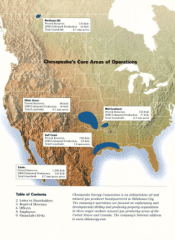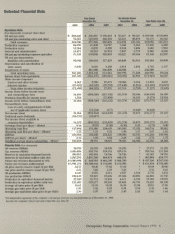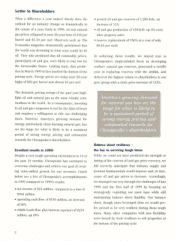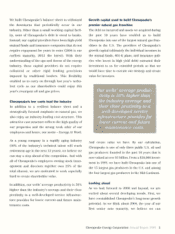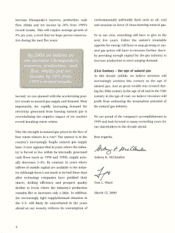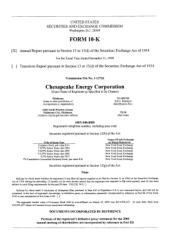Chesapeake Energy 1999 Annual Report Download - page 12
Download and view the complete annual report
Please find page 12 of the 1999 Chesapeake Energy annual report below. You can navigate through the pages in the report by either clicking on the pages listed below, or by using the keyword search tool below to find specific information within the annual report.
PART I
ITEM 1. Business
General
Chesapeake Energy Corporation ("Chesapeake" or the "Company") is an independent oil and gas company
engaged in the development, exploration, acquisition and production of onshore natural gas and oil reserves in the
United States and Canada. Chesapeake began operations in 1989 and completed its initial public offering in 1993.
Its common stock trades on the New York Stock Exchange under the symbol CHK. The Company's principal
offices are located at 6100 North Western Avenue, Oklahoma City, Oklahoma 73118 (telephone 405/848-8000 and
website address of chkenergy.com).
Chesapeake owns interests in approximately 4,700. producing oil and gas wells concentrated in three primary
operating areas: the Mid-Continent region of Oklahoma, western Arkansas, southwestern Kansas and the Texas
Panhandle; the Gulf Coast region consisting primarily of the Austin Chalk Trend in Texas and Louisiana and the
Tuscaloosa Trend in Louisiana; and the Helmet area of northeastern British Columbia. During 1999, the Company
produced 133.5 Bcfe, making Chesapeake one of the 15 largest public independent oil and gas producers in the
United States.
Business Strategy. From inception .as a start-up in 1989 through today, Chesapeake's business strategy has been
to aggressively build and develop one of the largest onshore natural gas resource bases in the U.S. The Company
has executed its strategy through a combination of active drilling and acquisition programs during the past 10 years.
Based on its view that natural gas will become the fuel of choice in the 2l century to meet growing power demand
and increasing environmental concerns, Chesapeake believes its strategy will deliver attractive returns and
substantial growth opportunities in the years ahead.
1999 Highlights. In the challenging oil and gas environment of 1999, the Company focused its efforts on drilling
lower risk developmental wells, acquiring reserves at the lowest possible cost, divesting of higher cost and non-
strategic properties and maintaining a capital expenditure budget closely tied to operating cash flow and proceeds
from asset sales. Despite experiencing 20-year lows in oil and gas pricing during the first half of 1999, Chesapeake
achieved considerable operating and financial progress during the year. Listed below are a few of Chesapeake's
accomplishments in 1999 compared to 1998's results:
net income of $33 million, compared to a net loss of $934 million
-cash flow from operations (before changes in working capital) of $139 million, an increase of 18%
proved oil and gas reserves of 1,206 Bcfe, an increase of 11%
-oil and natural gas production of 133.5 Bcfe, an increase of 3%
reserve replacement of 186% at a cost of $0.65 per Mcfe
In addition, Chesapeake's operating cost structure remained among the lowest of all publicly traded independent
energy producers during 1999. The Company's per unit operating costs (consisting of general and administrative
expenses, production expenses, production taxes, and depreciation, depletion and amortization of oil and gas
properties) were $1.26 per Mcfe of production, resulting in an operating margin of $0.84 per Mcfe. The Company's
low costs are attributable to its focus on developing highly productive natural gas properties, its efficient and
motivated employees, and the successful integration of advanced drilling and completion expertise with its large
inventory of undeveloped leasehold.
During 1999 and early 2000, Chesapeake was successful in defeating two material pieces of litigation against the
Company. First, in the 1996 Union Pacific Resources Corporation patent infringement litigation involving
horizontal drilling, the U.S. District Court in Ft. Worth dismissed the lawsuit, ruling in September 1999 that a patent
previously granted to UPRC was invalid and therefore Chesapeake could not have infringed upon it. Second, in
March 2000, the U.S. District Court in Oklahoma City dismissed a class action securities suit which had been
pending against the Company since 1997.
-2-


